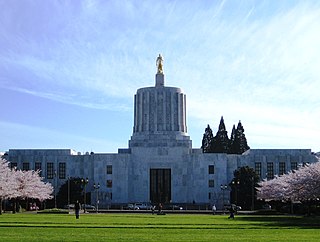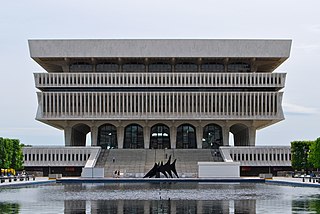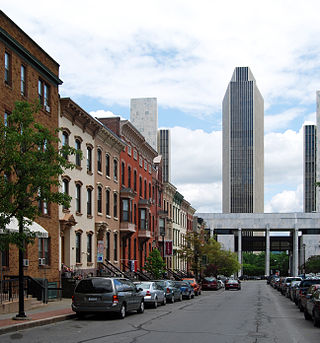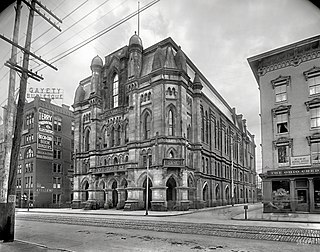
The Triangle Shirtwaist Factory fire in the Greenwich Village neighborhood of Manhattan, New York City, on Saturday, March 25, 1911, was the deadliest industrial disaster in the history of the city, and one of the deadliest in U.S. history. The fire caused the deaths of 146 garment workers – 123 women and girls and 23 men – who died from the fire, smoke inhalation, falling, or jumping to their deaths. Most of the victims were recent Italian or Jewish immigrant women and girls aged 14 to 23; of the victims whose ages are known, the oldest victim was 43-year-old Providenza Panno, and the youngest were 14-year-olds Kate Leone and Rosaria "Sara" Maltese.

John Alden Dix was an American businessman and politician who served as 38th governor of New York from January 1911 to January 1913.

The World Trade Center in New York City collapsed on September 11, 2001, as result of the al-Qaeda attacks. Two commercial airliners hijacked by al-Qaeda terrorists were deliberately flown into the Twin Towers of the complex, resulting in a total progressive collapse that killed almost 3,000 people. It is the deadliest and costliest building collapse in history.

The Smithsonian Institution Building, more commonly known as the Smithsonian Castle or simply The Castle, is a building on the National Mall housing the Smithsonian Institution's administrative offices and information center. Built as the first Smithsonian museum building, it is constructed of Seneca red sandstone in the Norman Revival style. It was completed in 1855 and designated a National Historic Landmark in 1965.

The Missouri State Capitol is the home of the Missouri General Assembly and the executive branch of government of the U.S. state of Missouri. Located in Jefferson City at 201 West Capitol Avenue, it is the third capitol to be built in the city. The domed building, designed by the New York City architectural firm of Tracy and Swartwout, was completed in 1917.

The Oregon State Capitol is the building housing the state legislature and the offices of the governor, secretary of state, and treasurer of the U.S. state of Oregon. It is located in the state capital, Salem. Constructed from 1936 to 1938 and expanded in 1977, the current building is the third to house the Oregon state government in Salem. The first two capitols in Salem were destroyed by fire, one in 1855 and the other in 1935.

The New York State Capitol, the seat of the New York state government, is located in Albany, the capital city of the U.S. state of New York. The capitol building is part of the Empire State Plaza complex on State Street in Capitol Park. Housing the New York State Legislature, the building was completed in 1899 at a cost of US$25 million, making it the most expensive government building of its time. It was listed on the National Register of Historic Places in 1971, then included as a contributing property when the Lafayette Park Historic District was listed in 1978. The New York State Capitol was declared a National Historic Landmark in 1979.

The New York State Museum is a research-backed institution in Albany, New York, United States. It is located on Madison Avenue, attached to the south side of the Empire State Plaza, facing onto the plaza and towards the New York State Capitol. The museum houses art, artifacts, and ecofacts that reflect New York’s cultural, natural, and geological development. Operated by the New York State Education Department's Office of Cultural Education, it is the oldest and largest state museum in the US. Formerly located in the State Education Building, the museum now occupies the first four floors of the Cultural Education Center, a ten-story, 1,500,000-square-foot (140,000 m2) building that also houses the New York State Archives and New York State Library.

The Library of Michigan is the state library of the U.S. state of Michigan, located in the state capital, Lansing. It is housed in the 5-story Michigan Library and Historical Center building. The library's purpose is to collect and preserve Michigan publications, conduct reference and research, and support libraries statewide.

The New York State Library is a research library in Albany, New York, United States. It was established in 1818 to serve the state government of New York and is part of the New York State Education Department. The library is one of the largest in the world by number of items held, with over 20 million cataloged items in 2011.

Albany City Hall is the seat of government of the city of Albany, New York, United States. It houses the office of the mayor, the Common Council chamber, the city and traffic courts, as well as other city services. The present building was designed by Henry Hobson Richardson in the Romanesque style and opened in 1883 at 24 Eagle Street, between Corning Place and Pine Street. It is a rectangular three-and-a-half-story building with a 202-foot-tall (62 m) tower at its southwest corner. The tower contains one of the few municipal carillons in the country, dedicated in 1927, with 49 bells.

The Oregon Supreme Court Building is the home to the Oregon Supreme Court, Oregon Court of Appeals, and the Oregon Judicial Department. Located in the state capitol complex in Salem, it is Oregon's oldest state government building. The three-story structure was completed in 1914 and currently houses the state's law library, and once housed the Oregon State Library.

The Brown Building is a ten-story building that is part of the campus of New York University (NYU), which owns it. It is located at 23–29 Washington Place, between Greene Street and Washington Square East in the Greenwich Village neighborhood of Manhattan, New York City, and is best known as the location of the Triangle Shirtwaist Factory fire of March 25, 1911, which killed 146 people.
The Monarch Underwear Company fire occurred in Manhattan, New York City at 623 Broadway on March 19, 1958. Twenty-four people were killed in a loft fire, between Houston Street and Bleecker Street and fifteen more were injured. Six of the injured were hurt when they leaped from the building and missed fire nets. The conflagration began in the third floor textile printing plant of an edifice in which the workrooms of several businesses were located. Ten corpses were found underneath work benches of the Monarch Underwear Company, on the fourth floor. The fire started at 4:30 p.m. and lasted one and a half hours. It began in a processing oven of the S.T.S. Textile Company.

The New York State Education Building[a] is a state office building in Albany, New York. It houses offices of the New York State Education Department (NYSED) and was formerly home to the New York State Museum and New York State Library. Designed by Henry Hornbostel in the Beaux-Arts style and opened in 1912, the building is known for its expansive colonnade.

The Center Square/Hudson–Park Historic District is located between Empire State Plaza and Washington Park in Albany, New York, United States. It is a 27-block, 99-acre (40 ha) area taking in both the Center Square and Hudson/Park neighborhoods, and Lark Street on the west. In 1980 it was recognized as a historic district and listed on the National Register of Historic Places.

The following events occurred in March 1911:

The Patent Office fire of 1877 was the second of two major fires of the U.S. Patent Office. It occurred in the 1864 Patent Office Building of Washington, D.C., on September 24, 1877. The building was constructed to be fireproof, but many of its contents were not. About 80,000 models and 600,000 copy drawings were burned to some degree. No patents were completely lost, however, and the Patent Office was soon reopened for recordings.

The New York Court of Appeals Building, officially referred to as Court of Appeals Hall, is located at the corner of Eagle and Pine streets in central Albany, New York, United States. It is a stone Greek Revival building built in 1842 from a design by Henry Rector. In 1971 it was listed on the National Register of Historic Places, one of seven buildings housing a state's highest court currently so recognized. Seven years later it was included as a contributing property when the Lafayette Park Historic District was listed on the Register.

Columbus City Hall was the city hall for Columbus, Ohio, located on Capitol Square in the city's downtown. The building served the mayor and city council from its construction in 1872 until its demolition in 1921. The building was the founding site for the United Mine Workers of America in 1890. In 1928, the site became home to the Ohio Theatre, and the current Columbus City Hall opened nearby.

















